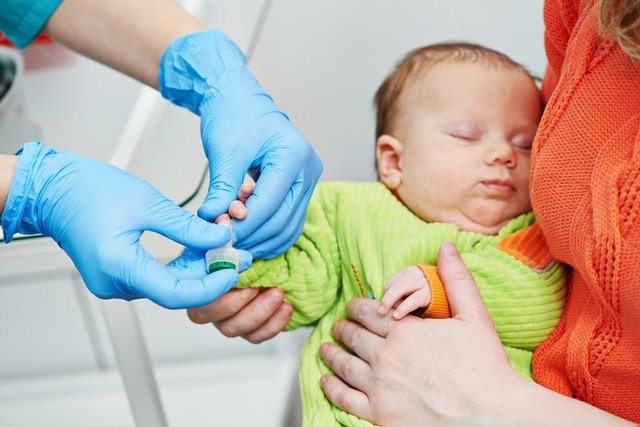Neonatal hypoglycemia corresponds to a decrease in glucose levels in the baby’s blood that can be noticed between 24 and 72 hours after birth. This condition is more common in babies who were born prematurely, large or small for gestational age, or whose mother had inadequate nutrition during pregnancy. It is considered neonatal hypoglycemia when:
- Glucose is below 40 mg/dL in full-term babiesthat is, at the right time;
- Glucose is below 30 mg/dL in premature babies.
The diagnosis of neonatal hypoglycemia is made within 72 hours after birth by measuring the baby’s glucose concentration. It is important that the diagnosis is made as soon as possible so that treatment can be started and, thus, complications such as permanent brain damage and even death can be avoided.

Symptoms of neonatal hypoglycemia
Most cases of neonatal hypoglycemia do not lead to the appearance of signs or symptoms, however when it is prolonged or when the circulating glucose level is very low, the baby may present some symptoms, the main ones being:
- Excessive sleep;
- Cyanosis, in which the baby’s skin turns bluish;
- Change in heart rate;
- Weakness;
- Respiratory change.
Furthermore, if neonatal hypoglycemia is not controlled, it is possible that there will be some complications, such as coma, brain impairment, learning difficulties and even death. Therefore, it is important that the diagnosis is made within the first few hours after birth and, if it is not made but the symptoms appear after a few days of birth, it is important to go to the pediatrician so that the diagnosis can be made and treatment can begin. .
Main causes
The causes of neonatal hypoglycemia are related to the mother’s habits and health condition. The baby is more likely to have hypoglycemia when the mother suffers from gestational diabetes, uses alcohol or medication during pregnancy, does not have diabetes under control and has inadequate nutrition, for example.
Furthermore, the baby may have low glycogen stores or excessive insulin production, which is more common in newborns of diabetic mothers, and feeding should occur every 2 or 3 hours according to the pediatrician’s instructions.
How the treatment is carried out
Treatment for neonatal hypoglycemia is established by the pediatrician and breastfeeding is normally recommended every 3 hours, waking the baby if necessary, so that glucose levels can be regulated more easily. If breastfeeding is not enough to regulate the baby’s glucose levels, it may be necessary to administer glucose directly into the vein.
Bibliography
- SBP GUIDELINES – HYPOGLYCEMIA IN THE NEONATAL PERIOD. Brazilian Society of Pediatrics. 2015. Available at: <https://www.sbp.com.br/fileadmin/user_upload/2015/02/diretrizessbp-hipoglicemia2014.pdf>. Accessed on June 11, 2021

Sign up for our newsletter and stay up to date with exclusive news
that can transform your routine!
Warning: Undefined array key "title" in /home/storelat/public_html/wp-content/plugins/link-whisper-premium/templates/frontend/related-posts.php on line 12
Warning: Undefined array key "title_tag" in /home/storelat/public_html/wp-content/plugins/link-whisper-premium/templates/frontend/related-posts.php on line 13




